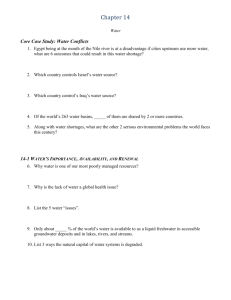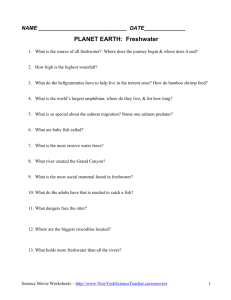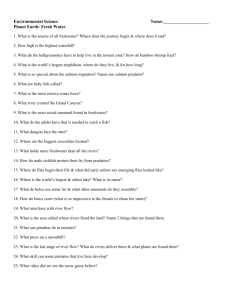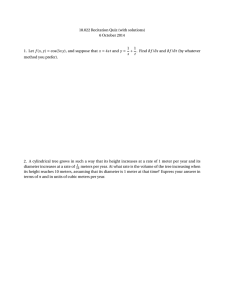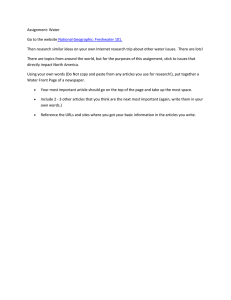Freshwater - AAAS Atlas of Population and Environment
advertisement
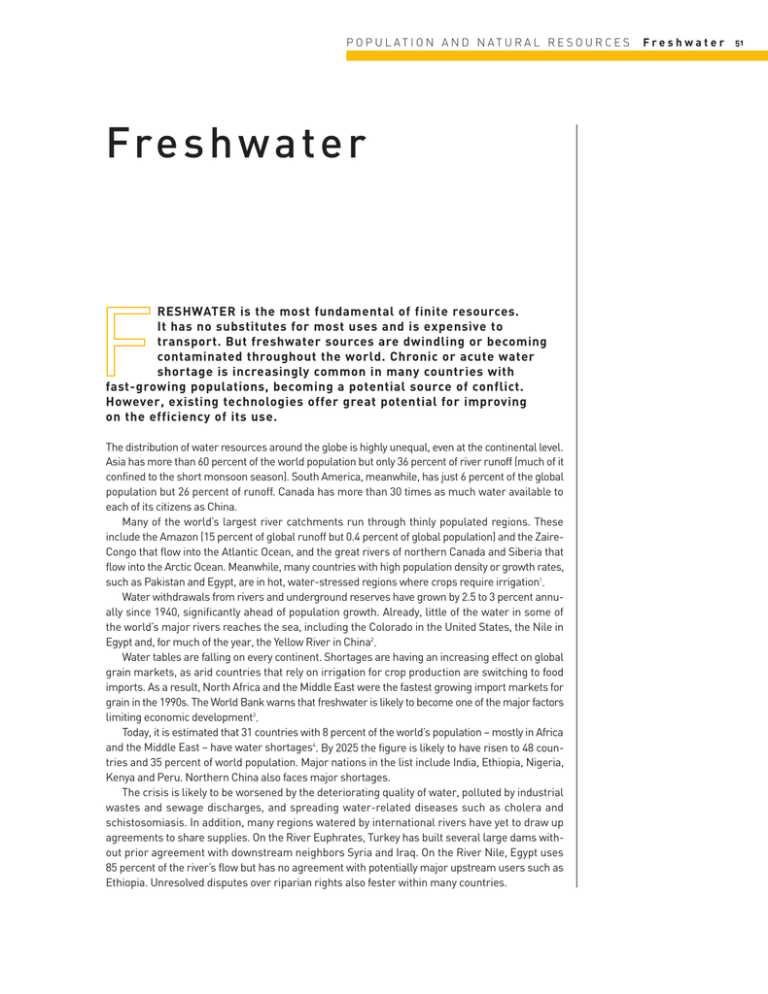
P O P U L AT I O N A N D N AT U R A L R E S O U R C E S Fre s h w a t e r RESHWATER is the most fundamental of finite resources. It has no substitutes for most uses and is expensive to transport. But freshwater sources are dwindling or becoming contaminated throughout the world. Chronic or acute water shortage is increasingly common in many countries with fast-growing populations, becoming a potential source of conflict. However, existing technologies offer great potential for improving on the efficiency of its use. F The distribution of water resources around the globe is highly unequal, even at the continental level. Asia has more than 60 percent of the world population but only 36 percent of river runoff (much of it confined to the short monsoon season). South America, meanwhile, has just 6 percent of the global population but 26 percent of runoff. Canada has more than 30 times as much water available to each of its citizens as China. Many of the world’s largest river catchments run through thinly populated regions. These include the Amazon (15 percent of global runoff but 0.4 percent of global population) and the ZaireCongo that flow into the Atlantic Ocean, and the great rivers of northern Canada and Siberia that flow into the Arctic Ocean. Meanwhile, many countries with high population density or growth rates, such as Pakistan and Egypt, are in hot, water-stressed regions where crops require irrigation1. Water withdrawals from rivers and underground reserves have grown by 2.5 to 3 percent annually since 1940, significantly ahead of population growth. Already, little of the water in some of the world’s major rivers reaches the sea, including the Colorado in the United States, the Nile in Egypt and, for much of the year, the Yellow River in China2. Water tables are falling on every continent. Shortages are having an increasing effect on global grain markets, as arid countries that rely on irrigation for crop production are switching to food imports. As a result, North Africa and the Middle East were the fastest growing import markets for grain in the 1990s. The World Bank warns that freshwater is likely to become one of the major factors limiting economic development3. Today, it is estimated that 31 countries with 8 percent of the world’s population – mostly in Africa and the Middle East – have water shortages4. By 2025 the figure is likely to have risen to 48 countries and 35 percent of world population. Major nations in the list include India, Ethiopia, Nigeria, Kenya and Peru. Northern China also faces major shortages. The crisis is likely to be worsened by the deteriorating quality of water, polluted by industrial wastes and sewage discharges, and spreading water-related diseases such as cholera and schistosomiasis. In addition, many regions watered by international rivers have yet to draw up agreements to share supplies. On the River Euphrates, Turkey has built several large dams without prior agreement with downstream neighbors Syria and Iraq. On the River Nile, Egypt uses 85 percent of the river’s flow but has no agreement with potentially major upstream users such as Ethiopia. Unresolved disputes over riparian rights also fester within many countries. Freshwater 51 P O P U L AT I O N A N D N AT U R A L R E S O U R C E S WHERE THE W AT E R I S Freshwater F R E S H W AT E R R E S O U R C E S , 1 9 9 8 Cubic meters available per capita per year ALL WATER Less than 1 000 of which: Oceans 97.5% 1 000-2 000 Freshwater 2.5% 2 000-5 000 of which: 5 000-10 000 Ice caps and glaciers 79% 10 000-20 000 Easily accessible Groundwater surface freshwater 20% 1% 20 000-100 000 More than 100 000 of which: Insufficient data Lakes 52% Source: World Bank. * Latest available data, ranging from 1975 to 1995 Syria 500 Iran 0 Romania 500 Swaziland 1 000 Suriname 1 000 Pakistan 1 500 Bulgaria 1 500 Madagascar 2 000 Canada 2 000 Chile 2 500 Guyana Note: Data on freshwater withdrawals are incomplete. These figures range from 1980 to 1998. 2 500 Afghanistan 18.6 26.2 18.1 61.0 21.3 17.0 1.7 0.7 85.8 63.4 34.4 9.1 94.5 0.5 6.1 3 000 Cubic meters USA 525.5 500.0 447.7 155.6 91.4 77.8 77.1 74.3 70.0 58.1 57.5 55.4 55.1 54.9 54.3 5 723 3 000 Tajikistan China India USA Pakistan Japan Mexico Russia Indonesia Iran Uzbekistan Italy Philippines Egypt Brazil Vietnam T O P P E R - C A P I TA W AT E R U S E R S * Kazakhstan Billion % of cubic meters available withdrawn resources Azerbaijan ANNUAL F R E S H W AT E R WITHDRAWALS To p 1 5 c o u n t r i e s Kyrgyzstan Source: FAO. Iraq Rivers 1% Water within living organisms 1% Atmospheric water vapor 8% Countries with less than 1 000 cubic meters available per person per year are considered to be water-scarce, while those with less than 2 000 cubic meters are recognized as chronically short of water. Those with 2 000-5 000 cubic meters may also experience acute water shortages for a part of the year. More countries are reaching these levels of shortage, with population growth a contributing factor alongside decreasing resources. Uzbekistan Soil moisture 38% Turkmenistan 52 0 Source: WRI. P O P U L AT I O N A N D N AT U R A L R E S O U R C E S Freshwater 53 WATER USE BY SECTOR* Selected countries Billion cubic meters: Industry Agriculture Domestic China India 25.0 15.0 26.3 94.6 404.6 460.0 USA Japan 35.8 120.9 17.4 15.5 58.5 291.0 France 6.1 4.9 Egypt 3.3 4.4 29.6 47.4 Brazil Germany 6.5 11.5 Source: UNEP-WCMC; WRI. 33.5 9.9 39.8 A V E R A G E A N N U A L P R E C I P I TA T I O N Millimeters Argentina UK 0.3 4.6 1.9 2.6 0-100 100-200 200-400 400-600 600-1 000 1 000-1 500 1 500-2 000 2 000-3 000 More than 3 000 21.5 7.2 Lithuania Gabon 0.0009 0.0045 0.0006 0.0022 0.0243 0.0072 * Latest available data, ranging from 1980 to 1998 Source: IIASA. Source: World Bank. P O P U L AT I O N A N D N AT U R A L R E S O U R C E S 54 GLOBAL LAND AREA UNDER I R R I G AT I O N 1963 1968 1973 1978 1983 1988 1993 1998 0 50 100 150 200 250 300 Million hectares Source: FAO. L A N D DA M AG E D B Y I R R I GAT I O N , 1 9 8 0 s To p f i v e i r r i g a t o r s Million % of hectares irrigated of land land damaged damaged India China USA Pakistan USSR World 20.0 7.0 5.2 3.2 2.5 60.2 36 15 27 20 12 24 Source: UNEP. W AT E R L O S T I N I R R I G AT I O N 55% water loss Field application losses 25% Transmission to farm 15% Farm distribution losses 15% Water effectively used by crops 45% Source: FAO. Freshwater More than 60 percent of the water used in the world each year is diverted for irrigating crops. Egypt, which must irrigate all its crops, uses more than five times as much water per capita as Switzerland. In Asia, which has two thirds of the world’s irrigated land, 85 percent of water goes for irrigation. A worldwide doubling in the area under irrigation to more than 260 million hectares underpinned the “green revolution” that kept the world fed in the late 20th century. Almost 40 percent of the global food harvest now comes from the 17 percent of the world’s croplands that are made productive in this way5. In some countries there is an increasing reliance on pumping underground water, often at rates that rainfall cannot replenish. Libya, for instance, by pumping “fossil” water from deep beneath the Sahara desert, uses seven times more water annually for irrigation than it receives in rainfall. India is pumping water at twice the recharge rate, causing some water tables to fall by between 1 and 3 meters a year. The country’s grain production could fall by 25 percent if it gave up groundwater “mining”6. Most irrigation schemes around the world are extremely inefficient. Typically, less than half the water reaches crop roots. Much of it is misdirected or evaporates. Meanwhile, over-irrigation combined with inadequate drainage is causing an accumulation of salt that is reducing yields in many of the areas under irrigation. Sometimes there are major ecological impacts. Irrigation projects developed by the former Soviet Union in Central Asia to grow cotton have dramatically emptied the Aral Sea, destroying fisheries, depopulating large areas and causing epidemics of disease. Faced with growing water shortages in many parts of the world, the main choice is between supply-side and demand-side solutions. Supply-side solutions imply more large dams and large water transfer projects. Aid agencies are increasingly reluctant to fund such projects because they have a history of heavy cost over-runs, poor financial returns, and ecological and social damage through flooded valleys and disrupted fluvial ecosystems. They have concluded that demand-side solutions offer better returns and less collateral damage. Economic analyses have demonstrated that investment in industrial and domestic water-saving devices (such as low-flush lavatories), in lining irrigation canals and in drip-feed irrigation saves more water more cheaply than can be won from dams and other supply schemes. Many believe that as water becomes an increasingly scarce and valued resource, it will become commodified. Where it was once seen as available by right, it might be bought and sold at market prices. This offers potential benefits in its more efficient use, as water prices more closely reflect its cost, but this also holds new dangers for the poor. A thousand tons of water can produce a ton of wheat, worth US$200, but it can expand industrial output by US$14 0007. If the price of water were to reflect its “true” cost, there is a danger that only the wealthy industrialized sector could afford it, with serious consequences for world food availability.
